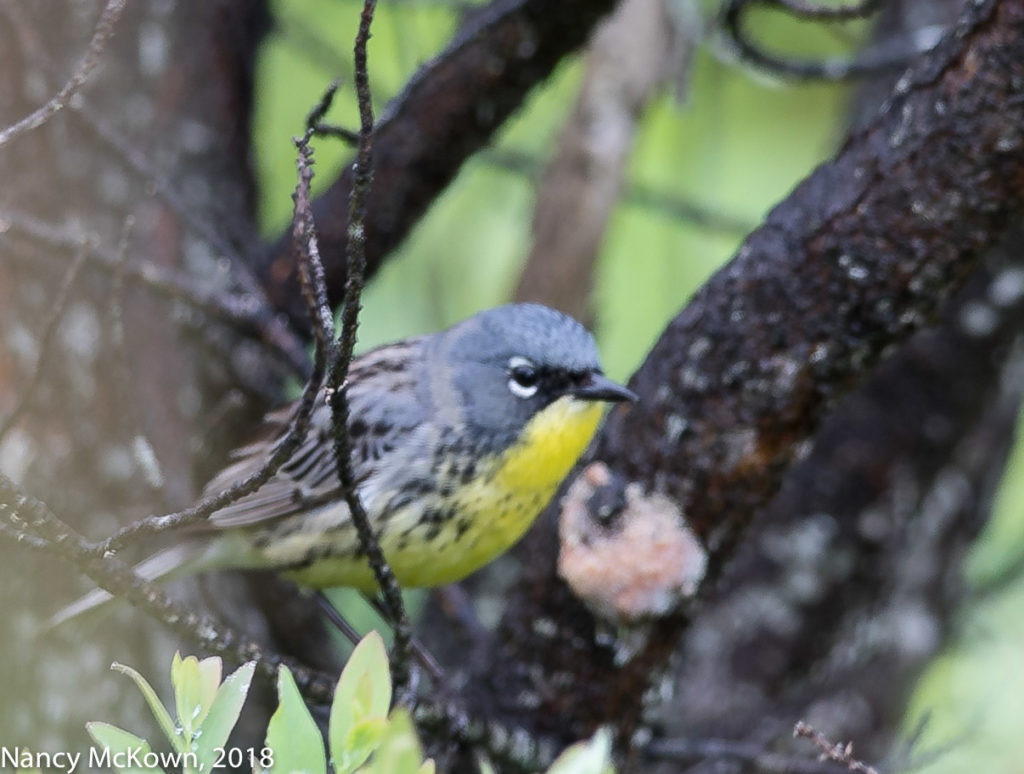Photographing a Kirtland’s Warbler
Have you ever been really good at something – a skill that you’ve worked hard at for years, and then, just because a new and different scenario presented itself, you abandon your serious study, experience, and calm, self assured practices only to misjudge your options and royally screw things up?
We drove up to Hartwick Pines State Park in Grayling, MI to the breeding grounds of the rare Kirtland’s Warbler. The MI DNR offers guided tours starting at 7:00am each morning during the first couple weeks of June. Around 30 “crazy birders” assembled at the visitors’ center for a quick information session and then we drove to one of the nesting areas approximately 20 miles away.

Note the slow shutter
speed causing the image to
be out of focus,
Extreme closeup,
ISO125; f/2.8; 1/80 Second
Kirtland’s Warbler Habitat Considerations
Like other warblers, the Kirtland’s are constantly on the move and careful to stay tucked behind the foliage, mostly near the bottom of the Jack Pine trees. (NOTE: I had imagined that I would have to point the camera way up to get shots of this bird, but the Kirtland’s Warblers are only attracted to a habitat consisting of 80+ acres of young, short Jack Pine trees (5 ft-20 ft. tall)).
#1 Kirtland’s Warbler Tour Rule: Stay on the designated path! No wandering off to follow the bird song. (NOTE: These warblers build their nests in the sandy soil under the Jack Pine trees. There’s a $10,000 fine for disturbing a nest.) Handheld cameras were allowed – no flash, no tripod. I opted to take the lighter 5D Mark IV and my fast 300mm 2.8 L lens. The morning was rainy, dark, cold and windy.
What Was I Thinking?
Before we got there, I reasoned (wrongly) that I needed to concentrate on tracking fast moving birds and, with no tripod, I would not have time to fumble with Manual (M) mode. Impusively, I set the camera to Program (P) mode. (NOTE: In this mode, the camera is basically on customizable autopilot. After quick and careful algorithmic considerations, it will automatically set the aperture and shutter—but also allow the photographer to take back some on-the-fly exposure control using “program shift”.)
Frustrating Moments
Bird song in the air brought excitement and anticipation. In hushed tones, birders around me were pointing their fingers and lifting their cameras. I became caught up in trying to follow their directions with both eyes and then (hand holding the tripod collar to keep the camera and lens steady) relocating that position with my 300mm lens.
NOTE: It is not uncommon for me to spend many frustrating moments trying to re-find a fast moving warbler that I saw with two eyes, but lost once I peered through the lens. I must direct the lens and quickly re-locate that spot while looking through the much narrower field of view of the lens, all in a highly charged instant. If the warbler is bouncing in and out of the viewfinder, and then gets lost in densely packed undergrowth, there is no choice but to lift my eye off of the viewfinder, search with two eyes until I am able to catch sight of it again and then redirect the lens. This is more easily done with a tripod and Gimbal tripod head.
The Kirtland’s Warbler finally did come out from behind the foliage…the lens locked focus and I got in 5 quick shots before he was gone. I looked at the LCD screen and was aghast at the exposure settings the camera chose. I quickly switched the camera to Manual mode (M) so I could better control the shutter speed.
Autopilot Algorithms
Apparently Canon cameras set to Program (P) mode will not necessarily incorporate (into the autopilot algorithm) the rule about how the shutter speed on a hand held camera should be set at least to the equivalent focal length of the lens. In this case, it appeared to “reason” exactly the opposite. After reviewing the paltry selection of exposure settings that might work on a dark damp day, the camera’s logic favored close to baseline ISO and consequently, sacrificed a fast shutter and tight aperture in the process.
So….Canon cameras’ complex autopilot algorithmic logic did not match my intentions or expectations about basic camera shake avoidance rules. Perhaps Canon camera designers, mathematicians and engineers just assume that they need not worry about associating auto pilot with camera shake on high-end DSLR cameras. They reason that an advanced user will no doubt take the easy way out, forego automation, and just directly choose the exposure settings that she knows will work.

Out of focus due to
hand holding and high winds and
slow shutter speed
ISO100; f/2.8; 1/80th second
Lesson Learned
Lesson learned… When a specific (fast) camera shutter speed is critical to the shot….don’t use Program (P) Mode, especially on a windy day. DUH! I did not see another Kirtland’s Warbler for the rest of the tour.
NOTE: This experience was an effort to get out of my comfort zone. I’m spoiled here in my private bird space even though we saw very few migrating warblers this Spring. I missed the convenience being able to direct the camera from the vantage of a tripod and Gimbal tripod head within the comfort of my own home.
Bottom line: As a bird photographer, I’m not going to be continually challenged and rewarded with anticipatory delight unless I get myself and my gear out there. So I will go and try to let experience be my guide.









Boo. so sorry things didn’t go as you’d planned they would. Perhaps next year!